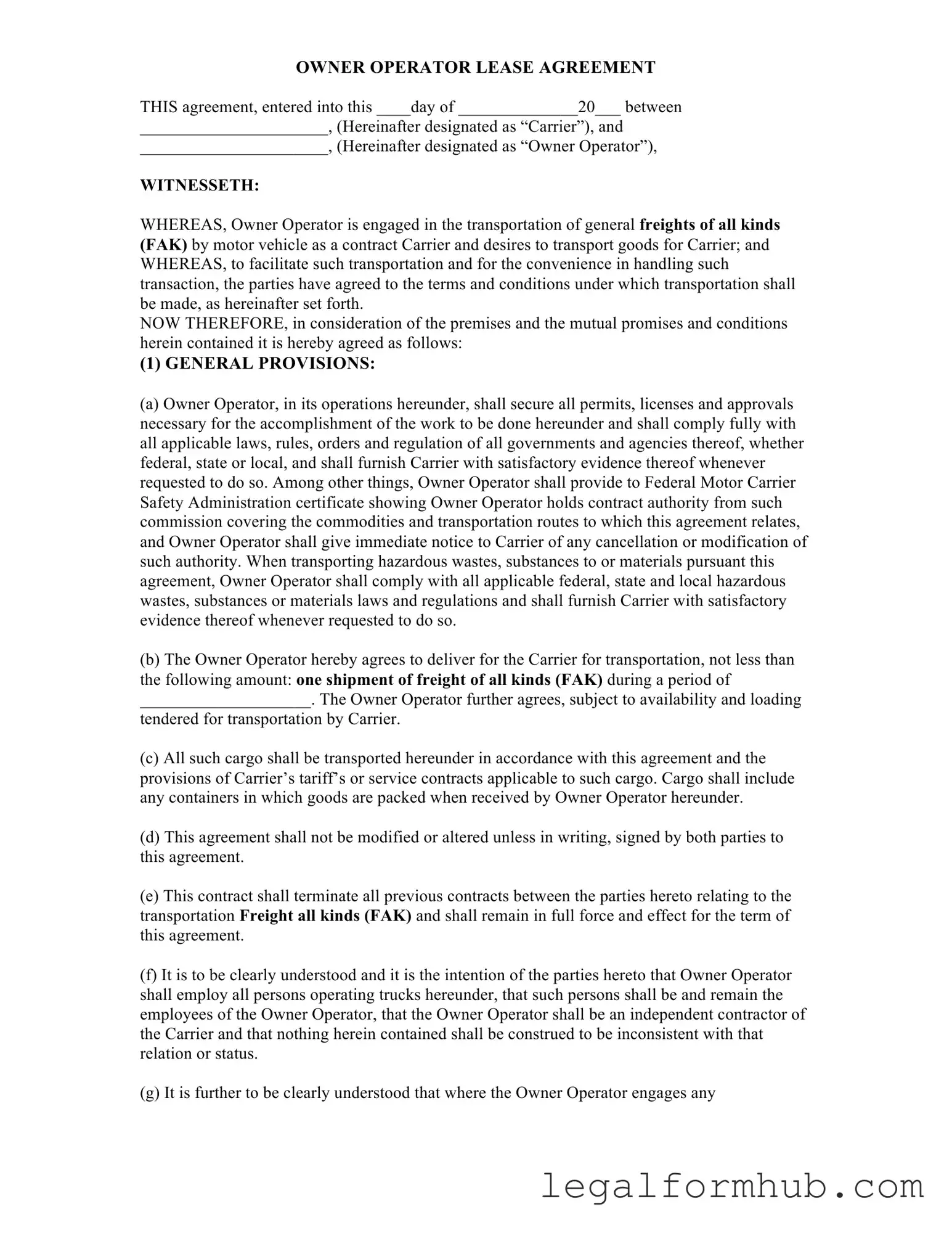The Owner Operator Lease Agreement shares similarities with a Bill of Lading. A Bill of Lading serves as a receipt for goods and a contract between the shipper and carrier. Like the Owner Operator Lease Agreement, it outlines the responsibilities of each party regarding the transportation of goods. Both documents ensure that there is a clear understanding of the terms under which the goods are transported, including the condition of the cargo upon receipt and the obligations of the carrier to deliver the goods safely.
Another document that resembles the Owner Operator Lease Agreement is the Freight Broker Agreement. This agreement establishes the relationship between a freight broker and a carrier. Similar to the Owner Operator Lease Agreement, it outlines the terms of service, payment, and liability. Both documents emphasize the importance of compliance with applicable laws and regulations, ensuring that all parties understand their responsibilities in the transportation process.
The Independent Contractor Agreement is also akin to the Owner Operator Lease Agreement. This type of agreement defines the working relationship between a contractor and a client. Like the Owner Operator Lease Agreement, it specifies that the contractor operates independently and is responsible for their own employees and liabilities. This distinction is crucial in maintaining the independent status of the contractor, just as it is for the Owner Operator.
A Master Service Agreement (MSA) is another document that shares similarities. An MSA outlines the general terms and conditions between two parties for future transactions or services. Much like the Owner Operator Lease Agreement, it establishes a framework for cooperation and sets expectations for compliance with laws and regulations. Both documents aim to create a clear understanding of the relationship and responsibilities involved in the services provided.
The Equipment Lease Agreement can also be compared to the Owner Operator Lease Agreement. An Equipment Lease Agreement outlines the terms under which one party leases equipment to another. Similarly, the Owner Operator Lease Agreement details the terms of transportation services provided by the owner operator to the carrier. Both agreements define responsibilities, liabilities, and the conditions under which the leased items or services must be maintained.
The Transportation Service Agreement is yet another document that resembles the Owner Operator Lease Agreement. This agreement outlines the terms under which transportation services are provided by a carrier to a shipper. Like the Owner Operator Lease Agreement, it includes provisions related to liability, compliance with regulations, and the responsibilities of each party during the transportation process.
A Non-Disclosure Agreement (NDA) shares some characteristics with the Owner Operator Lease Agreement, particularly in terms of confidentiality. An NDA protects sensitive information shared between parties, much like the confidentiality clause in the Owner Operator Lease Agreement. Both documents emphasize the importance of safeguarding proprietary information and outline the consequences of unauthorized disclosure.
The New York Articles of Incorporation is a vital document for anyone looking to establish a corporation in New York, effectively detailing essential information such as the corporation's name, purpose, and the address of its registered office. This form also includes information about the incorporators and other necessary components for legal compliance, making it crucial for proper state registration. For guidance on how to complete this form accurately, you can read here.
The Subcontractor Agreement is also similar to the Owner Operator Lease Agreement. This agreement outlines the relationship between a primary contractor and a subcontractor. Like the Owner Operator Lease Agreement, it specifies the responsibilities and liabilities of each party. Both documents ensure that the primary contractor retains control over the work performed while also protecting their interests in the event of issues arising from the subcontractor’s performance.
The Terms and Conditions document is another comparable document. This type of document outlines the rules and guidelines governing a transaction or service. Similar to the Owner Operator Lease Agreement, it defines the expectations and responsibilities of all parties involved. Both documents aim to create a clear understanding of the terms under which services will be provided, helping to prevent disputes.
Lastly, a Service Level Agreement (SLA) can be likened to the Owner Operator Lease Agreement. An SLA defines the expected level of service between a service provider and a client. Like the Owner Operator Lease Agreement, it outlines performance metrics, responsibilities, and consequences for not meeting agreed-upon standards. Both documents are essential for ensuring that all parties have a clear understanding of their obligations and the quality of service expected.
